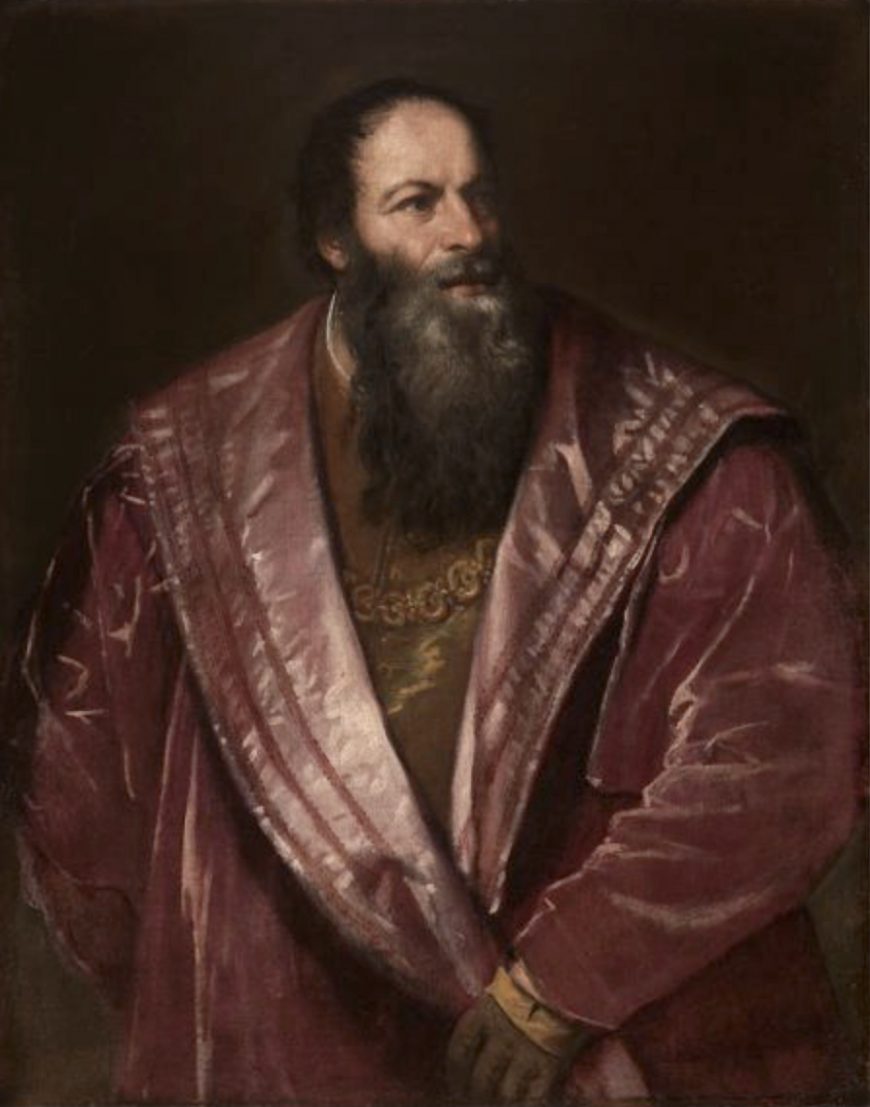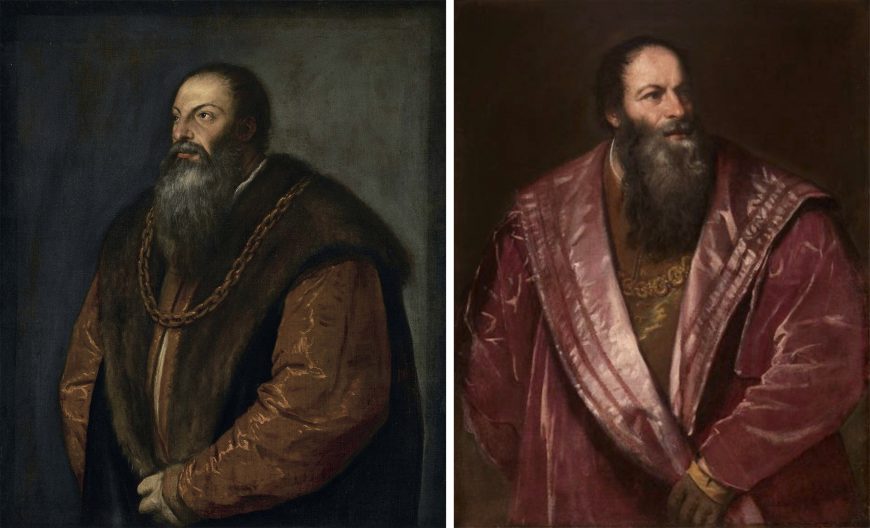
Titian, two portraits of Pietro Aretino, left: c. 1537, oil on canvas, 101.9 x 85.7 cm (The Frick Collection, New York), right: 1545, oil on canvas, 96.7 × 77.6 cm (Palazzo Pitti, Florence)
Titian was one of the most celebrated portraitists of the sixteenth century. He enjoyed a high degree of international fame which brought him portrait commissions from the most prestigious families and powerful rulers of Europe. Giorgio Vasari, his contemporary and the renowned author of biographies of Italian artists, wrote that “there is hardly any nobleman of repute, nor prince, nor great lady, who has not been portrayed by Titian.” Titian gave a new twist to portraiture. His portraits have a spark—something special and distinctive. A movement of the hand, a detail in the clothes, or a light in the eyes subtly discloses the inner layers of the sitter’s soul in a way never done before. Titian also had a talent for combining a convincing likeness with a certain amount of flattery.
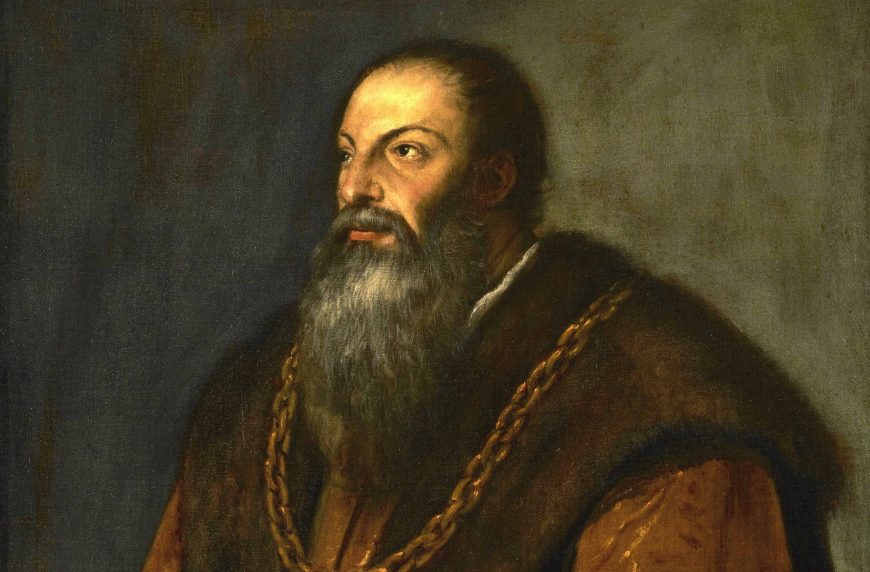
Titian, Detail of bust, Portrait of Pietro Aretino, c. 1537, oil on canvas, 101.9 x 85.7 cm (The Frick Collection, New York)
A lasting friendship
Pietro Aretino was a Tuscan writer, critic, and satirical poet, as well as an international publicist, an art agent, and a collector. He liked to call himself the “scourge of princes.” After some traveling he established himself in Venice where he met Titian, with whom he started a deep friendship that lasted for 30 years.
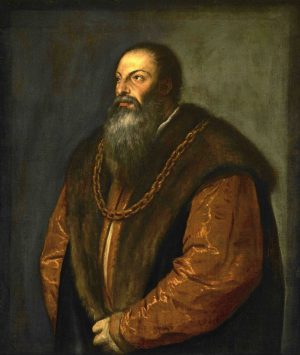
Titian, Portrait of Pietro Aretino, c. 1537, oil on canvas, 101.9 x 85.7 cm (The Frick Collection, New York)
Aretino was known for his brash style, brilliant wit, bold impudence, and licentiousness. He was a controversial character, but through his charm and persuasiveness he managed to enjoy prominent international friends and patrons throughout his life. Titian’s rapid ascent was also due to the help of Aretino, who assiduously promoted his work as his agent and publicist. Aretino introduced Titian to the nobles of Europe, and in return he acquired a reputation as an arbiter of taste and was admired for being close to such a celebrated artist. Titian is mentioned in many of Aretino’s letters, while Aretino was painted by Titian on a few occasions, two of which are discussed in this essay.
Portrait of Pietro Aretino in the Frick Collection, New York
In this portrait, Aretino occupies the entire canvas with his large, imposing presence. The neutral background allows the sitter to forcefully stand out, while the limited palette vibrates with touches of light on the sleeves and the wriggling golden chain infuses the composition with a touch of life.
With confident and visible brushstrokes, Titian presents his friend in a bust length, three-quarter view. His body and face are turned in the same direction, suggesting assertiveness and determination. His face, in fully illuminated against the shadowy background, becomes the focus of the composition. Through his composition, Titian highlights the centrality of Aretino’s bold and brazen intelligence.
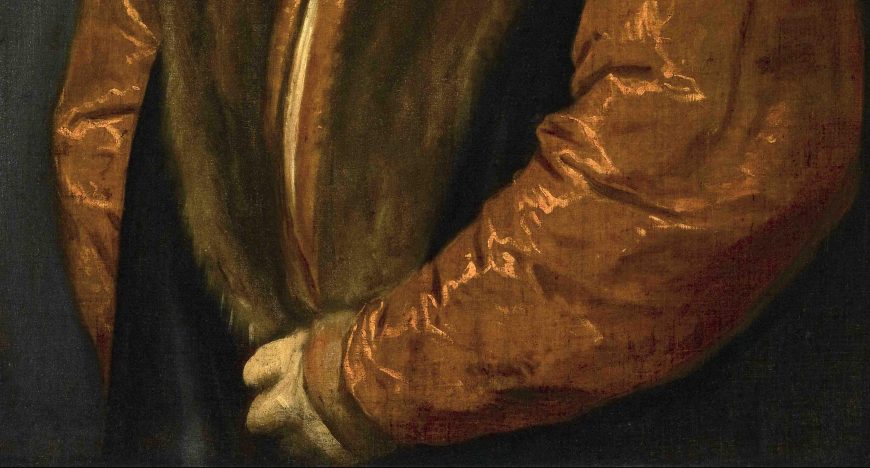
Titian, Detail of sleeve, Portrait of Pietro Aretino, c. 1537, oil on canvas, 101.9 x 85.7 cm (The Frick Collection, New York)
Aretino was the son of a cobbler and was making a living as a writer, but Titian has portrayed him wearing patrician clothing. Aretino’s fur coat displays voluminous sleeves of precious fabric, gloves, and a golden chain, a gift from one of his powerful friends. Aretino’s strong-willed face and bulky chest lends the portrait a degree of conventionality which is contradicted by the roughly-sketched gloved hand that is casually holding his pelisse closed.
Portrait of Pietro Aretino in the Palazzo Pitti, Florence
Like the portrait in the Frick Collection, the sitter’s massive body takes up the whole canvas here. Rough brushstrokes give the painting an unfinished, pulsating effect. The source of illumination coming from the left creates a gleam on the velvet of the coat, depicted in a variety of pinkish-red shades, while part of Aretino’s face and the background are left in shadow. The thinning hair and the disheveled beard are the same as those depicted eight years before, but Aretino’s face appears more deeply creased and expresses a new intensity that was well known to his contemporaries.
As in the previous portrait, Aretino wears the characteristic accessories of the upper classes, including gloves and a heavy golden chain (probably a gift of Francis I, king of France), but here the view of the body is frontal, while his head is in a three-quarter view. With this twist, Titian freezes a moment in time in the life of the writer. The movement, the flickering light, and the sharply focused eyes charge the image with a psychological power. The Venetian artist again communicates his friend’s provocative intelligence and self-assertiveness.
An unsuccessful gift
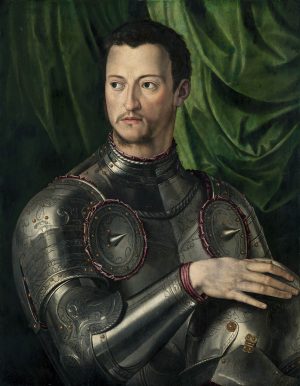
Bronzino, Cosimo de Medici in Armor,
c. 1545, oil on panel, 76.5 x 59 cm (Museo Nacional Thyssen-Bornemisza, Madrid)
Aretino sent his portrait to Cosimo I de’ Medici, Grand Duke of Tuscany, in a failed attempt to obtain patronage for himself and Titian. It is possible that the painting was not appreciated, at least initially, as it was a far cry from the taste of the Florentine court, whose favorite portraitist at the time was Bronzino. Bronzino’s sitters are characterized by impassive faces, their bodies outlined by crisp contours and presented in static positions amidst a timeless, almost crystalline atmosphere. Bronzino’s approach diverged fundamentally from Titian’s passionate, quick hand and his preference for color over line.
Aretino was aware of this and, maybe jokingly, in the letter accompanying the portrait wrote: “to be sure, it breathes, its pulse beats, and its spirit moves just as I am in life. And if I had paid more scudi, the materials would indeed have become glowing, soft, or stiff like silk and brocade.”
We don’t know what Titian thought about these words, but we do know that Aretino loved the portrait, referring to it as “an awesome marvel” and as a “continuous mirror of my very self.”
Bucking tradition together
These two portraits tell us about the long friendship between the celebrated Venetian painter and Aretino, one of the most insolent writers of his times. Together, they also express Titian’s talent for rendering human psychology through dense strokes of color.

